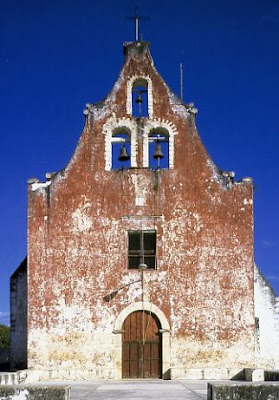Tetiz
Second only to the Virgin of Izamal, the Virgin of Tetiz today enjoys the greatest devotion of any marian santo in Yucatan. Thereby hangs a tale:
Early in 1746 the newly appointed Spanish bishop of Yucatan, Francisco Martínez de Tejada had occasion to pass through Tetiz, then an impoverished visita of the main regional mission at Hunucmá. The church, such as it was, was described as, "... made of sticks and straw, and in the final stages of decay."
As he approached the simple wooden image of the Virgin on the altar, the bishop recognised her features as those of a pious but poor woman he had once known in Seville, who, on receiving alms of a silver peso, had promised to rebuild "a ruined house for herself and her son."
Early in 1746 the newly appointed Spanish bishop of Yucatan, Francisco Martínez de Tejada had occasion to pass through Tetiz, then an impoverished visita of the main regional mission at Hunucmá. The church, such as it was, was described as, "... made of sticks and straw, and in the final stages of decay."
As he approached the simple wooden image of the Virgin on the altar, the bishop recognised her features as those of a pious but poor woman he had once known in Seville, who, on receiving alms of a silver peso, had promised to rebuild "a ruined house for herself and her son."
When the astonished prelate raised the hem of the Virgin's robe to kiss it, he saw the same peso coin resting underneath. Amazed and inspired by this seemingly miraculous sign, the bishop immediately undertook to build a new church on the same spot - the present church - and dedicate it to the Virgin of The Assumption.
Raised on a platform built with stones from a demolished Maya pyramid nearby, the single nave of the church extends westward from the remains of a 16th century chapel, terminating in a facade with a lofty espadaña bordered by baroque scrolls.
This distinctive church front is strikingly similar to several other Yucatecan facades of the mid-1700s rebuilt during the stewardship of Bishop Martínez de Tejada. All feature rectangular fronts capped by elegant espadañas in the form of rising concave curves bookended by prominent carved scrolls, and pierced by tiers of arched bell openings.
This distinctive church front is strikingly similar to several other Yucatecan facades of the mid-1700s rebuilt during the stewardship of Bishop Martínez de Tejada. All feature rectangular fronts capped by elegant espadañas in the form of rising concave curves bookended by prominent carved scrolls, and pierced by tiers of arched bell openings.
Itzimná
The first colonial building in this former Maya village on the outskirts of Mérida—originally named for Itzamná, the ancient Mayan reptilian sky deity—was an arched Indian chapel, part of which may form the fabric of the raised sanctuary of the present church. Usually painted red and crowned by a lofty, scrolled espadaña, the facade of this attractive 18th century church is a prominent landmark in this now fashionable suburb.
Cacalchén
Cacalchén is close to the Maya site of Aké. Behind its walled forecourt, the 18th century church is also graced by an espadaña with projecting scrolls strikingly similar to those at Itzimná and Tetiz.
At the rear stand the remnants of an earlier mission, complete with portería, carved convento doorway, and what may be an original posa chapel—now the domed Chapel of St. Francis. The entire structure is raised on a platform, probably of ancient Maya origin.
At the rear stand the remnants of an earlier mission, complete with portería, carved convento doorway, and what may be an original posa chapel—now the domed Chapel of St. Francis. The entire structure is raised on a platform, probably of ancient Maya origin.
Tahdzibichén
Like those at Cacalchén, Itzimná and Tetiz, the church was rebuilt under the auspices of bishop Francisco Martínez de Tejada, whose inscribed escutcheon is displayed over the frieze above the doorway. Unfortunately, the fine gilded retablos he reportedly installed inside the church are no longer in evidence.
text and facade images © Richard D. Perry. All rights reserved
for itineraries and full details on the colonial churches of Yucatán, order our classic guide

















































